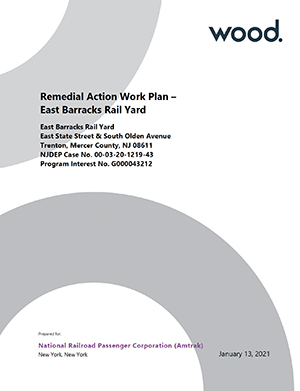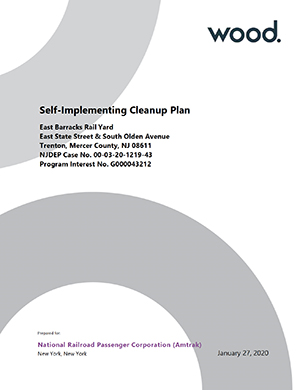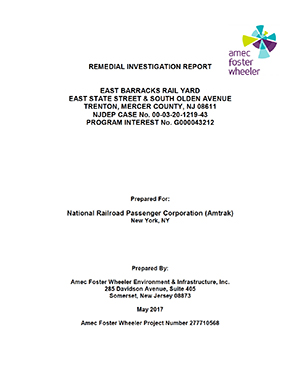
East Barracks Trenton Rail Yard
East Barracks Trenton Rail Yard
Site Location
Trenton, NJ
Contact Us
If you have questions or comments on the restoration plans for these sites, contact AskEnvironmental@Amtrak.com.
Beginning in March 2023, Amtrak began the environmental restoration of the Amtrak-owned East Barracks rail yard site (“the site”). The site is 2.2 acres in size, located at the northwestern end of Cook Avenue behind PJ Hill Elementary School and Greg Grant Park. The site’s soil was impacted by PCB-containing oils from historic rail operations. The restoration project includes excavation, loading and offsite transportation of approximately 10,400 cubic yards of contaminated soils and other materials.
Amtrak acquired the East Barracks rail yard in April 1976 from the Pennsylvania Central Transportation Company (Penn Central) pursuant to the Regional Rail Reorganization Act of 1973. New Jersey Transit (NJT) and Penn Central and its predecessors used the rail yard for overnight storage of electric-powered, self-propelled passenger rail equipment for the Northeast Corridor rail line. NJT leased the yard from Amtrak but has not operated in the yard for several years. Amtrak has never used the yard for train operations and currently uses it for the storage of rail equipment used to maintain the railroad right-of-way. The site consists of active and former rail lines and spurs, one crew office trailer and a vehicle parking area.
Impacts to the soil at the site were originally investigated by NJT, who reported a discharge of PCBs to the New Jersey Department of Environmental Protection (NJDEP) in 2000. The discharge was attributed to leaking transformers on electric rail cars. A Remedial Investigation (RI), performed to identify the extent of the impact, discovered impacts in the soil at varying concentration levels. NJT installed a geotextile liner over the existing ballast, between and within the railroad tracks and placed an additional one-foot layer of clean ballast on top of the geotextile liner to limit the migration of PCBs.
Site Location Map

Site Plan

As the site owner, Amtrak has continued the remedial investigation activities. The Remedial Investigation Report (RIR) was completed in May 2017 and recommended a Self-Implementing Cleanup Plan (SICP) under the Toxic Substance Control Act (TSCA). The SICP was submitted to and approved by the U.S. Environmental Protection Agency (EPA) in March 2020, and later modified in January 2021. The restoration work at the site is overseen by a Licensed Site Remediation Professional (LSRP) in compliance with NJDEP regulations. Amtrak has restored two adjoining properties (not Amtrak-owned) to meet the NJDEP Residential cleanup standard.
The restoration goal for the site is to remove PCB-impacted soil to meet the NJDEP Non‐Residential cleanup standard. The restoration of the Amtrak property is separated into two phases.
Phase 1, which restored the site north of Cook Avenue, was conducted in March through June 2023. Phase 2 work to restore the site’s southern section was completed in the summer of 2024. Earthwork disturbances were performed in accordance with the Soil Erosion and Sediment Control Plan (SESCP) that was approved by the Mercer County Soil Conservation District in March 2020. During restoration activities, Amtrak performed perimeter air monitoring to prevent any air quality exceedances beyond the property line. The site has been restored and revegetated under the SESCP. New Jersey-certified clean backfill soil was used to fill excavated areas. During Spring 2025, Mercer County Soil Conservation District will visit the site to ensure revegetation in accordance with the certified SESCP.
A total of 3,233 tons of TSCA-regulated PCB-impacted material and 12,217 tons of non-hazardous PCB-impacted material were excavated, transported and disposed of from Amtrak property. Amtrak and its consultant are preparing a Remedial Action Report (RAR) that will summarize all investigation and remediation activities performed at the site anticipated to be submitted in Spring 2025.
Prior to performing any environmental restoration work, the Trenton School District was informed of Amtrak’s work plan for the site and provided permission for restoration work to begin. The initial work included the cleanup of the PJ Hill Elementary School property bordering the site. Work schedules were coordinated with the school to minimize impacts on school bell and bus schedules.
In accordance with NJDEP regulation, N.J.A.C. 7:26.C Administrative Requirements for the Remediation of Contaminated Sites, Licensed Site Remediation Professional (LSRP) signage was posted at the East Barracks site advising the public of the environmental restoration work that was occurring.
Amtrak welcomes public comments and questions on the restoration plan for this site and the remaining work to be completed.
Project Documents
Access documents related to the East Barracks Restoration project at https://njems.nj.gov/DataMiner.
Search Options
- Select Search by category
- Select Site Remediation
- Select Attachments Available in Site Remediation
- Enter PI number: G000043212 (case sensitive)
Amtrak Guest Rewards
Forgot Password?
Passwords are case sensitive, should be at least 10 characters long and should include 1 uppercase and 1 lowercase alpha character, 1 number and 1 special character. ! " # $ % & ' ( ) * + , - . / : ; < = > ? @ [ \ ] ^ _ ` < | > ~
Enter the email address or member number associated with your account. We will send password reset instructions.
An email with password reset instructions is on the way.
That answer wasn’t correct either. We’ve sent you an email with instructions to reset your password instead.


